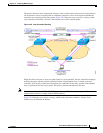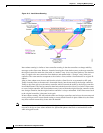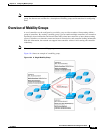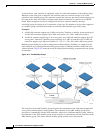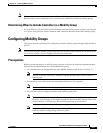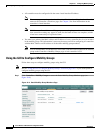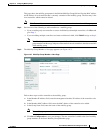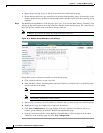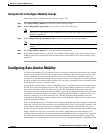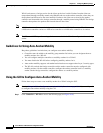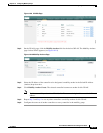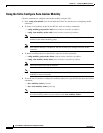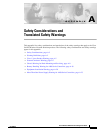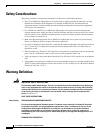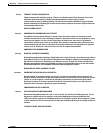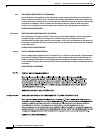
10-11
Cisco Wireless LAN Controller Configuration Guide
OL-8335-02
Chapter 10 Configuring Mobility Groups
Configuring Auto-Anchor Mobility
Using the CLI to Configure Mobility Groups
Follow these steps to configure mobility groups using the CLI.
Step 1 Enter show mobility summary to check the current mobility settings.
Step 2 Enter config mobility group name group_name to create a mobility group.
Note Enter up to 31 case-sensitive ASCII characters for the group name. Spaces are not allowed in
mobility group names.
Step 3 Enter config mobility group member add mac-address ip-addr to add a group member.
Note Enter config mobility group member delete mac-address ip-addr if you want to delete a group
member.
Step 4 Enter show mobility summary to verify the mobility configuration.
Step 5 Repeat this procedure on every controller to be included in the mobility group. All controllers in the
mobility group must be configured with the MAC address and IP address of all other mobility group
members.
Configuring Auto-Anchor Mobility
Use auto-anchor mobility (or guest WLAN mobility) to improve load balancing and security for roaming
clients on your wireless LANs. Under normal roaming conditions, client devices join a wireless LAN
and are anchored to the first controller that they contact. If a client roams to a different subnet, the
controller to which the client roamed sets up a foreign session for the client with the anchor controller.
However, using the auto-anchor mobility feature, you can specify a controller or set of controllers as the
anchor points for clients on a wireless LAN.
In auto-anchor mobility mode, a subset of a mobility group is specified as the anchor controllers for a
WLAN. You can use this feature to restrict a WLAN to a single subnet, regardless of a client’s entry
point into the network. Clients can then access a guest WLAN throughout an enterprise but still be
restricted to a specific subnet. Auto-anchor mobility can also provide geographic load balancing because
the WLANs can represent a particular section of a building (such as a lobby, a restaurant, and so on),
effectively creating a set of home controllers for a WLAN. Instead of being anchored to the first
controller that they happen to contact, mobile clients can be anchored to controllers that control access
points in a particular vicinity.
When a client first associates to a controller of a mobility group that has been preconfigured as a mobility
anchor for a WLAN, the client associates to the controller locally, and a local session is created for the
client. Clients can be anchored only to preconfigured anchor controllers of the WLAN. For a given
WLAN, you should configure the same set of anchor controllers on all controllers in the mobility group.
When a client first associates to a controller of a mobility group that has not been configured as a
mobility anchor for a WLAN, the client associates to the controller locally, a local session is created for
the client, and the controller is announced to the other controllers in the same mobility group. If the
announcement is not answered, the controller contacts one of the anchor controllers configured for the



